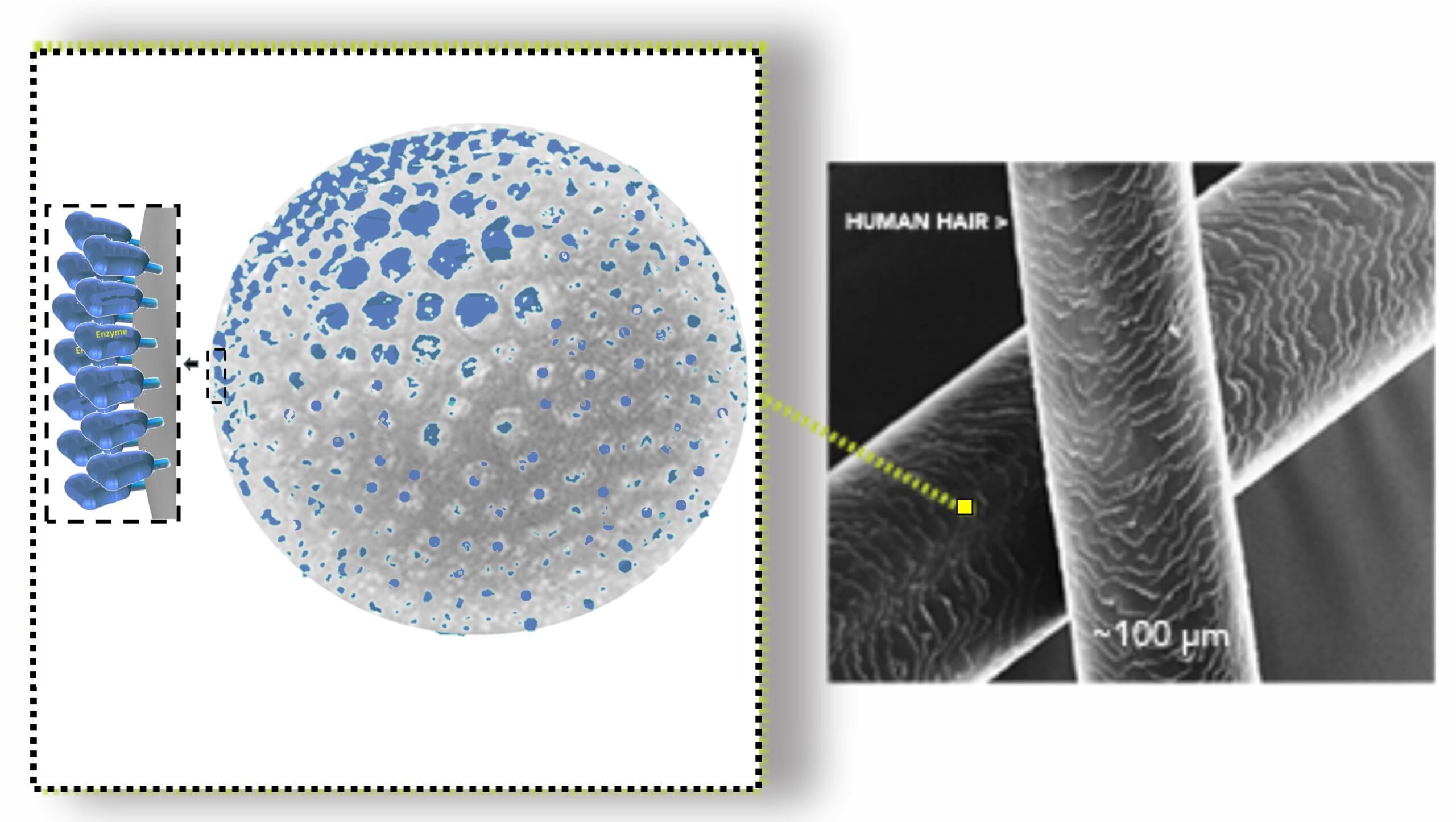
TET Tethered Enzyme Technology (TET) comes from the groundbreaking work by Professor Alex Travis and Roy Cohen at Cornell University that replicates the way that enzymes attach to mammalian sperm providing improved stability and activity. Professors Travis and Cohen have evolved these patented techniques to facilitate fast, high sensitivity catalytic coupled reactions that are first being applied to the detection of biomarkers including proteins, enzymes, viruses and Micro-RNAs.
Initially funded by a prestigious NIH Pioneer Award because of its transformative potential, the underpinnings of our technology have been developed with over $6M in grants and academic support. TET nanobots are capable of performing chemical operations with high sensitivity, specificity, and ultra-rapid speed typically with improved amplification and read-out time faster than when based on antibody-antigen interactions. Tethering of enzymes to nanoparticles also results in extraordinary stability, with NSE-FAST having an early lab-tested freezer shelf life of over one year. Multiple types of nanobots can be combined in test and reaction control wells in our unique 12 well strips, on a standard assay plate or in other assemblies to perform diverse chemical operations such as detection of a wide variety of analytes and biomarkers. TET enables a practically infinite array of possible reactions – a true multi-purpose molecular software platform.
Company History
 Tethered Enzyme Technology (TET) was inspired by nature. Studies of how sperm generate energy to swim revealed that they attach the enzymes that metabolize sugar to a solid structure down the length of the sperm tail. This solid-state design lets them carry out complex reactions in a small space and with high efficiency—producing energy exactly where it is needed. We recognized that if we could copy their design on man-made surfaces such as nanoparticles, then we could create ultra-fast molecular machines, that could perform an almost endless variety of functions. This concept of attaching enzymes to structures to add function has been around for decades, but the most common methods of attachment usually result in the enzymes having low activity. However, by copying the design of sperm, we were the first to show coupled reactions from a biological pathway tethered to a single surface (REF to Mukai paper). We showed the enormous advantage of TET versus traditional tethering methods (REF to Gao paper), and we were able to show that TET reactions showed even greater activity than those same enzymes in solution (REF to 2015 paper). The advantages of TET have enabled us to exponentially increase the complexity of tethered enzymatic reactions, demonstrating a 10-step tethered reaction, metabolizing glucose to lactate, as done in the sperm tail (REF Mukai Angewandte paper).
Tethered Enzyme Technology (TET) was inspired by nature. Studies of how sperm generate energy to swim revealed that they attach the enzymes that metabolize sugar to a solid structure down the length of the sperm tail. This solid-state design lets them carry out complex reactions in a small space and with high efficiency—producing energy exactly where it is needed. We recognized that if we could copy their design on man-made surfaces such as nanoparticles, then we could create ultra-fast molecular machines, that could perform an almost endless variety of functions. This concept of attaching enzymes to structures to add function has been around for decades, but the most common methods of attachment usually result in the enzymes having low activity. However, by copying the design of sperm, we were the first to show coupled reactions from a biological pathway tethered to a single surface (REF to Mukai paper). We showed the enormous advantage of TET versus traditional tethering methods (REF to Gao paper), and we were able to show that TET reactions showed even greater activity than those same enzymes in solution (REF to 2015 paper). The advantages of TET have enabled us to exponentially increase the complexity of tethered enzymatic reactions, demonstrating a 10-step tethered reaction, metabolizing glucose to lactate, as done in the sperm tail (REF Mukai Angewandte paper).
Because of the enormous potential for medical diagnostics and therapeutics, our work has received much attention, from our first abstract being chosen for a press release by the American Society for Cell Biology (approximately one of 20 out of 10,000), to significant press coverage of our Pioneer Award from the National Institutes of Health. On the strength of our pre-clinical data distinguishing patients with brain injury from those with mimics, our solid intellectual property with multiple issued patents and more at various stages of prosecution, and those enormous potential impacts, TETmedical was founded in December 2021. At this time, TETmedical is transitioning from work in the Cornell laboratories of Drs. Cohen and Travis to its new home in the Cornell Center for Life Science Ventures incubator.
Product Development Strategy and Pipeline
Recognizing that TET enables remarkable sensitivity, speed, and versatility, TETmedical is focusing our first products on medical conditions where rapid, quantitative measurements of biomarkers or analytes are urgently needed, and current diagnostics do not exist. Brain injuries such as stroke presented an obvious first target, and this is our most advanced product in the pipeline, with the NSE Functional Activity Stroke Test (NSE-FAST) preparing for 2025 FDA clinical testing with trial completion in 2026.
In addition to the NSE-FAST, TETmedical’s platform technology continues to expand as we develop tests for other conditions for which there are no adequate diagnostic solutions.
The COVID-19 pandemic presented new medical challenges to the world, including the need to quickly distinguish respiratory viral infections (e.g., influenza, COVID-19, or cold). Inspired by this urgent need, we invented new TET-based modalities for rapid diagnosis of viral infections from both RNA and DNA viruses. These IVD tests work in minutes, does not require thermocycling, highly sensitive, and can detect a specific pathogen variants and subtypes. This work is currently supported by the New York State Biodefense Commercialization Fund to develop a differential diagnostic test for respiratory viruses, with the potential for follow-on, Phase II funding to begin in September 2025.
Simultaneous with these efforts, we have also developed a TET-based modality to detect specific microRNA biomarkers. Using a similar strategy of identifying a medical need where rapid diagnosis is essential but no diagnostics currently exist, we chose to develop as a first product in this line, a point-of-care test for canine hemangiosarcoma. Work at Cornell from the laboratory of Dr. Scott Coonrod at the Baker Institute for Animal Health identified several candidate microRNA sequences that could identify canine hemangiosarcoma from similar conditions. We are performing early-stage product development toward this goal, with support from Cornell’s Riney Canine Health Center. Future TET products in this category will include rapid quantification of micro-RNA biomarkers for endometriosis and breast cancer, with the goal to potentially enable an alternative to painful and costly biopsies and mammograms.
In 2024, TETmedical began work supported by a Phase I NIH STTR grant to develop an at-home test capable of measuring ALT and AST without the need for venipuncture. These enzymes are the most common measures of liver function, identification of liver injury and track progression of liver disease. We have already demonstrated that TET biosensors can be integrated with blood separation via a simple lateral flow device. Coupling an existing at-home blood collection product with TET’s patented biosensors would eliminate the need for repeated visits to a clinical lab, or repeated home visits by a skilled nurse, needles, etc., opening a door for at-home testing to improve patient outcomes, while simultaneously reducing burden on patients and reducing costs for payers.
TETmedical’s future is exciting with the below diagram showing the status of our current pipeline of applications.

Scientific Papers
- Effects of Nanoparticle Size on Multilayer Formation and Kinetics of Tethered Enzymes
- Biomimicry Promotes the Efficiency of a 10-Step Sequential Enzymatic Reaction on Nanoparticles, Converting Glucose to Lactate
- Use of Tethered Enzymes as a Platform Technology for Rapid Analyte Detection
- Improved monitoring dynamics through use of a tethered enzyme biosensor to detect and quantify neuron-specific enolase activity levels in biofluids
- Biomimicry Enhances Sequential Reactions of Tethered Glycolytic Enzymes, TPI and GAPDHS
- The Potential for microRNA Therapeutics and Clinical Research

Patent Information
PATENT FAMILIES
There are 5 families of issued and pending patent patents as shown in the table below. These include 4 families of licensed IP from Cornell University and two patent applications in Family 5 that are joint patents of TETmedical and Cornell that are licensed to TETmedical by Cornell under a 2022 Memorandum of Understanding (MOU)
 Licensed Patents
Licensed Patents
In August 2022, TETmedical formally licensed from Cornell University, what is now 4 issued and 3 pending patents on the diagnostic use of TET. Three of the four issued patents apply to the TET rapid tests for acute brain injury associated with the NSE-FAST product. Pending patents apply to other applications including use of TET for rapid molecular detection of viruses and a test for nucleic acid biomarkers (e.g., micro-RNAs). The list of issued and published patents is below. The pending applications have the potential to allow customizable rapid detection of single strand RNA (e.g., viral genomic material, or micro-RNA biomarkers) with single-nucleotide specificity without the need for thermocycling.
JOINT Patents FILED BY TETMEDICAL (Family 5)
In December 2023, TETmedical filed two utility patents covering the innovative design of the NSE-FAST product including the specialty design of the TET strip, production of our bioengineered enzymes and their tethering, the process for layering the components into the strip, and concepts for at-home and point-of-care use of TET for diagnostic applications. New patents are being developed for design of TET products for rapid pathogen testing (bacteria, virus) and micro-RNA diagnostic applications.
TETMedical Filed Patents
In December 2022 TETmedical filed its first patent as a provisional patent covering the innovative design of the NSE-FAST including the design of the 12 well TET strip, production of the enzymes used, the tethering process, the process for layering the components into test, positive and negative control wells and concepts for at home and point of care use of TET for diagnostic applications. New patents are being developed for design of the products that use TET for virus and micro-RNA diagnostic applications.
TETMedical Filed Patents
In December 2022 TETmedical filed its first patent as a provisional patent covering the innovative design of the NSE-FAST including the design of the 12 well TET strip, production of the enzymes used, the tethering process, the process for layering the components into test, positive and negative control wells and concepts for at home and point of care use of TET for diagnostic applications. New patents are being developed for design of the products that use TET for virus and micro-RNA diagnostic applications.
Grant Funding Status
In addition to equity funding of the company, TETmedical/Cornell is currently funded from 3 grants totaling $1.25M with applications in for another $1.4M of grants.

